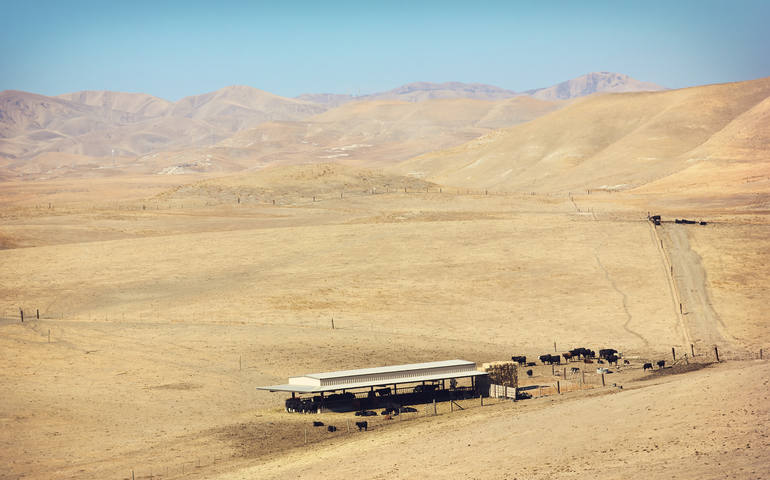
In 18 years living in Oakland, Calif., I learned that when our beautiful rolling hills remained green, all was well. The rains had favored us. If it was a dry year, the hills would turn a scorched golden brown, and we would pine and pray for the arrival of our winter rains.
Since 2011 scorched golden brown, stretching from north to south, has become California's prevailing color. Photos online emanating from my favorite place in the world are sad and troubling.
The rains have mostly forgotten the Golden State, now almost eight months into a drought state of emergency. The drought is one of the worst on record in the state. In late February, U.S. officials told Central Valley farmers they would not receive irrigation water from the federal government this year because of the water shortage.
The California Farm Water Coalition estimated that more than 500,000 acres of the Valley's nearly 6 million acres of farmland would remain fallow for the year, "the result of multiple dry years and federal environmental policies that prevent the full use of agricultural water supplies from being used for purposes for which they were intended – to grow food," said Mike Wade, executive director of the coalition.
Wade told Reuters Feb. 5 that the drought could affect 40 percent of the region's agricultural jobs, or about 117,000 people in the nation's top agricultural producing state in terms of cash receipts and grower of nearly half its fruits, nuts and vegetables.
[Related: "California bishops pray: 'God, rain o'er me'"]
The Central Valley has strong personal ties. I used to take the Amtrak from Oakland's Jack London Square down the coast to visit friends in Fresno. If it happened to be springtime, our train would roll past rows of abundantly blossoming almond trees.
But this summer as the Amtrak trains head for Fresno, their passengers might not have the heart to take in the harshness -- the dry-brown rolling hills off in the distance and the cracked soil where crops used to flourish this time of year.
Local community food banks and pantries are feeling the effects, as well.
Many farm workers and other agriculture-related employees have been laid off. There are not enough tomatoes, almonds or watermelons for them to harvest, transport on trucks, or process in the canning factories. As a result, these individuals are showing up in increasing numbers at local food banks and pantries for assistance, said Jody Hudson, operations manager for the Fresno diocese's Catholic Charities headquarters.
"Our numbers are starting to climb. Last week we were serving an average of 190 to 200 families a day at the Fresno site alone," Hudson said in an email.
In order to serve families living in outlying areas who cannot afford gas money to drive to town, Catholic Charities has set up several mobile outreach sites in Fresno, Merced and Kern counties.
At the Bakersfield location in Kern County, total families receiving emergency food has jumped from 1,849 in January to 2,142 in July. More striking, the same site served 878 families in January 2013 and 1,497 in July 2013, and 511 and 590, respectively, in the same periods in 2012.
Fresno County has seen a comparable rise in demand, serving roughly 2,200 to 2,300 families in the Januarys of 2012 and 2013, but roughly 800 more families in January this year; about 700 more families used its services this July compared to the last two years. Merced, on the other hand, has had relatively stable numbers of families receiving emergency food during those time periods, though serving a smaller population fluctuating between 300 and 500 families.
Rick Palermo, director of the Community Food Bank in Fresno, has a similar story to tell. His organization has added an additional five distribution locations in outlying areas to serve "anyone who has been affected by the drought," he told NCR.
"People start lining up at 5 a.m. That's an hour before our trucks leave the warehouse," he said.
Is this a worse-case scenario? Palermo says no. "We went through this in 2009-2010, the last drought-related disaster. This year is in a holding pattern," he said. If the weather situation stays the same, 2015 could bring even longer lines, he fears.
Elsewhere in in the city, Mike Maxwell, a volunteer outreach coordinator at Holy Spirit Catholic Church, worries about the prospect of a continuing drought. He, too, watches the weather maps.
"I keep track of the rain. I wish we had what you're getting in Ohio," he said, referencing the 12 inches and 40 days of rain that have fallen on Columbus since June.
Maxwell, a lifelong Californian, recently cheered when the Fresno County Board of Supervisors voted against bringing a high-speed bullet-train rail system through Fresno on its way from San Francisco to Los Angeles. Bringing in water should be the priority these days, Maxwell said.
"If they can build a Keystone [XL transnational] pipeline for oil, why can't there be one for transporting water to areas that need it?" he asks.
Meanwhile, parishes across Fresno are continuing to pray for rain, said Catholic Charities' Hudson.
Rain, that precious liquid that will be duly recorded in our newspaper weather maps of California in life-giving shades of green, washing away the dire burnt browns of drought.




